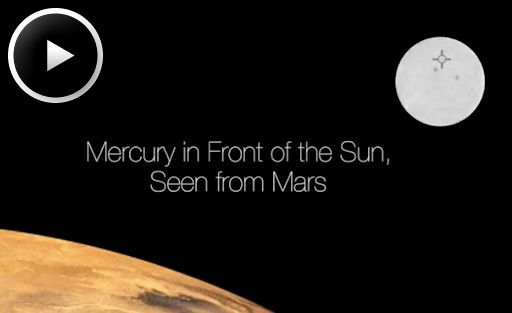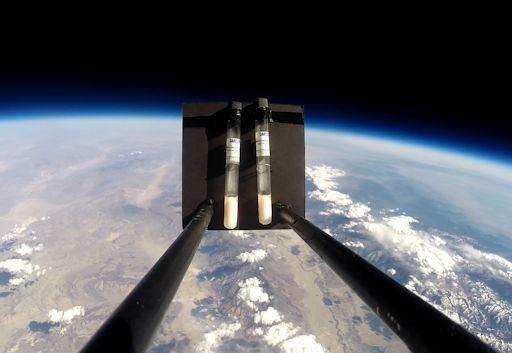Listen to radar echoes from satellites and meteors, live on listener-supported Space Weather Radio. | | |
POSSIBLE GEOMAGNETIC STORM TODAY: A coronal mass ejection hurled into space by the double X-flare of June 10th could sideswipe Earth's magnetic field today. NOAA forecasters estimate a 50% chance of polar geomagnetic storms in response to the glancing blow. Aurora alerts: text, voice
FRIDAY THE 13th FULL MOON: For soccer fans, Friday the 13th is a lucky day because the World Cup is underway. The world's biggest sports event began yesterday in Brazil with a game between the host country and Croatia. (Brazil won.) To celebrate the kickoff, Jean-Baptiste Feldmann took this picture of the Moon rising over Nuits-Saint-Georges, France:

The fact that this month's full Moon falls on Friday the 13th has been widely noted in the media. Such a coincidence is not particularly rare. The last Friday the 13th full Moon occurred in March 1998. The next one will be in August 2049.
Neither is the coincidence unlucky. Folklore holds that all kinds of wacky things happen under the light of a full Moon. Supposedly, hospital admissions increase, the crime rate ticks upward, and people behave strangely. The idea that the full Moon causes mental disorders was widespread in the Middle Ages. Even the word "lunacy," meaning "insanity," comes from the Latin word for "Moon." The majority of modern studies, however, show no correlation between the phase of the Moon and the incidence of crime, sickness, or human behavior. This is true even on Fridays.
Realtime Space Weather Photo Gallery
MARS ROVER SEES SOLAR TRANSIT: Last week NASA's Curiosity rover witnessed something no one has ever seen from the surface of another world: a planetary transit of the sun. As the sun rose over Mars' Gale Crater on June 3rd, Curiosity's two-eyed MastCam tracked the shadowy silhouette of Mercury crossing the solar disk:

In addition to showing Mercury, the same MastCam frames show two sunspots approximately the size of Earth.
This is the first transit of the sun by a planet observed from any planet other than Earth, and also the first imaging of Mercury from Mars. Mercury fills only about one-sixth of one pixel as seen from such a great distance, so the darkening does not have a distinct shape. Nevertheless, it is definitely Mercury as the shadow follows Mercury's expected path based on orbital calculations.
On Earth, it is possible to observe solar transits of Mercury and Venus, although they are rare. Last seen in June 2012, Venus transits are typically separated by more than a hundred years. The next Mercury transit visible from Earth will be May 9, 2016. Mercury and Venus transits are visible more often from Mars than from Earth, and Mars also offers a vantage point for seeing Earth transits. The next of each type visible from Mars will be Mercury in April 2015, Venus in August 2030 and Earth in November 2084.
Realtime Space Weather Photo Gallery
HALOBACTERIA SET A NEW HIGH-ALTITUDE RECORD: Astrobiologsts have long wondered if halobacteria, a terrestrial extremophile with a special talent for shielding itself from UV radiation, could survive on the planet Mars. To find the answer, the students of Earth to Sky Calculus have been flying halobacteria onboard balloons to the top of Earth's atmosphere. During their latest flight on June 7th, the microbes set a high-altitude record for their species. Here they are 116,524 feet above the Sierras of central California:

The previous record set by the students just last month was 112,000 feet, so this was nearly a mile higher than before.
During the June 7th flight, onboard sensors registered temperatures as low as -60 C, air pressures of 1% sea level, and cosmic radiation levels 25 times Earth-normal. Those are conditions akin to the planet Mars. Three hours after they were launched, the bacteria landed in the Death Valley National Park: snapshot. This means they experienced a 100 C swing in temperature, a 100-fold change in air pressure, and a 25-fold surge of radiation.
The students have already shown that halobacteria can survive trips like this. Now they are working to determine survival rates, growth curves, and to look at possible mutations among the halo-survivors. Results could contribute to an important body of knowledge about the prospects for life on Mars -- past, present, and future.
Realtime Space Weather Photo Gallery
Realtime Aurora Photo Gallery
Realtime Comet Photo Gallery
Realtime Meteor Photo Gallery
Every night, a network of NASA all-sky cameras scans the skies above the United States for meteoritic fireballs. Automated software maintained by NASA's Meteoroid Environment Office calculates their orbits, velocity, penetration depth in Earth's atmosphere and many other characteristics. Daily results are presented here on Spaceweather.com.
On Jun. 13, 2014, the network reported 6 fireballs.
( 6 sporadics)

In this diagram of the inner solar system, all of the fireball orbits intersect at a single point--Earth. The orbits are color-coded by velocity, from slow (red) to fast (blue). [Larger image] [movies]
Potentially Hazardous Asteroids (
PHAs) are space rocks larger than approximately 100m that can come closer to Earth than 0.05 AU. None of the known PHAs is on a collision course with our planet, although astronomers are finding
new ones all the time.
On June 13, 2014 there were potentially hazardous asteroids.
Recent & Upcoming Earth-asteroid encounters: | Asteroid | Date(UT) | Miss Distance | Size |
| 2011 PU1 | Jul 17 | 7.9 LD | 43 m |
| 2002 JN97 | Aug 2 | 61.4 LD | 2.0 km |
| 2001 RZ11 | Aug 17 | 34.2 LD | 2.2 km |
| 2013 WT67 | Aug 17 | 16.1 LD | 1.2 km |
Notes: LD means "Lunar Distance." 1 LD = 384,401 km, the distance between Earth and the Moon. 1 LD also equals 0.00256 AU. MAG is the visual magnitude of the asteroid on the date of closest approach. | | The official U.S. government space weather bureau |
| | The first place to look for information about sundogs, pillars, rainbows and related phenomena. |
| | Researchers call it a "Hubble for the sun." SDO is the most advanced solar observatory ever. |
| | 3D views of the sun from NASA's Solar and Terrestrial Relations Observatory |
| | Realtime and archival images of the Sun from SOHO. |
| | from the NOAA Space Environment Center |
| | the underlying science of space weather |

